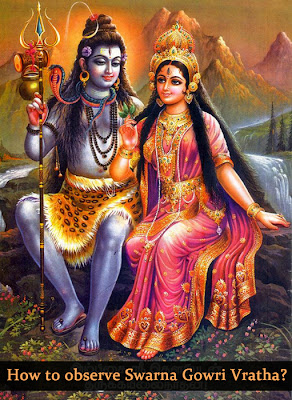This festival comes on Shukla Paksha Dwadasi, in the month of Karthik. This happens to be the last day of chatur maasa . On Uthana Dwadasi day Lord Vishnu is supposed to get up from sleep. It is said that a year in a humans life is one day to the gods. On Uthana Dwadasi day Lord Vishnu is stirring from his sleep. There are some stories connected to this too.
How to perform Tulasi Vishnu Vivaha
- On this day, Saligrama puja is important and Tulasi puja. In most houses Saligrama puja is performed and brahmin couples are given festival food and Tulasi Vivah is performed in the evening. After food, this couple are given thamboola and a minimum of blouse piece if not sari and shalya is presented along with Kheer Dana.
- For the evening naividya, 4/5 different kind of laddus and sweets are made, and also a flavored milk boiled well with sugar saffron and cardomom added. Koshambari is also made.
- An arathi is prepared as follows. On a plain silver or pithal plate draw a rangoli design with honey using a matchstick or a new toothpick. Over this sprinkle some Gasagase (poppey seeds) all over and then gently tap out the extra gasgase. You will now have a beautiful decoration on the plate. Over this arrange 5 amlas and wicks soaked in ghee over the amlas.
- For the Amlas in the Arati, make a dough with Haldi posder and water. Prepare equal sized balls and over this place the Amla and the wick soaked in oil. This will help balance the Amlas and prevent them from rolling over.
- Decorate the frontyard of the house with mango leaves and rangoli.
- Decorate the tulasi vrindavan - draw rangoli in front of the vrindavan. If there no place in the back yard for this , one may keep the pot or a small vrindvan with a tulasi plant near the god, for the puja.
- In the Tulasi vrindavan a small branch of amla is kept, a few amlas have also to be in the branches. Keep a small idol of Krishna in the Vrindavan, next to the plant and perform puja. Light as many lamps as possible.
- You will need to get ready the naividya, the arathi, sweet smelling flowers, a pair small garlands.
- Decorate the tulasi and put a few abharana( jewels, like we would decorate a bride). Sing songs and stotras to Tulasi and Krishna and Lakshmi, nd perform the puja.
- After the puja and before the various arathis, offer to the Lord and Tulsi, a sari and blouse and pair of dhotis offer haldhi kumkum and on to plate do the offer Mangala Dravya for Tulasi, then the naividya and the arathis. Puja is to performed with haldhi kumkum etc as we perform Lakshmi puja.
Prayers for Tulasi Pooja
Tulasi Praathane namah tulasi kalyaaNi namo vishhnu priye shubhe |namo moksha pradaayike devi namaH sampatpradaayike ||
Tulasige Namaskara
Yanmule sarva thirthani yanmadye sarva devatha |yadagre sarva vedashcha Tulasi thvam namam mayham ||
Tulasi Dyana
dyayescha tulasim devim shyamam kamala lochanamprasannam panmakalhara varabhaya chaturbhujakiritahara keyura kundaladi vibushitamdhavalankusha samyuktam nishedushim
Tulasi Ashhtottara Shatanamavali
Click here for Tulasi Ashtottara Shatanamavali in English and Kannada
The second half of Ashwija maasa and Kartic maasa are the darkest months of the year. Before the times of kerosene lamps and electric lights, it would have been very difficult to sight a village. When lamps are lit and kept in front of the houses in the evenings and early mornings the travellers could easily sight the village.
Amlas are given importance, as the coming months are cold with fog, which will cause cold etc. Amlas are an excellent source of Vitamin C, a preventive for winter ailments in the olden days.
 In places where a Amla tree is present, it is worshipped and revered. It is said that every house must have an Amla tree, a parijatha flower tree and a tulasi plant. Some even say that a house without a tulasi plant, is equal to cemetery.
In places where a Amla tree is present, it is worshipped and revered. It is said that every house must have an Amla tree, a parijatha flower tree and a tulasi plant. Some even say that a house without a tulasi plant, is equal to cemetery.
Growing a tulasi plant is not at all difficult only it needs to be watered every day.The plant has also be planted in a fairly big pot or brindhvan, so the plant will space for the roots to spread.
Any plant for that matter is like child. take care of it and it will grow well. The plant also needs to kept in sunny place. In summer when it is very hot, it can be watered twice or shifted to a shade.
Do grow a tulasi plant where ever you are.















